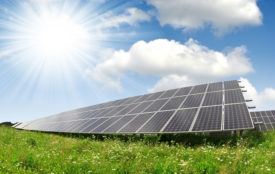Economics Alone Could Drive Greece to a Future Powered by Renewables
Greece can transform its power system away from heavy reliance on fossil fuels to potentially become one of the leaders of the energy transition in Europe by 2030, according to BloombergNEF’s (BNEF) Greece Market Outlook. Longer term, economics alone can drive Greece’s power sector to more than 90% renewable electricity by 2050.
BNEF maps a least-cost transition pathway for Greece’s power sector to 2050 — the first time BNEF has used its New Energy Outlook modeling to explore an economics-driven outlook for the country’s transition.
Today, some 70% of Greek electricity is generated from lignite, a low quality coal, and natural gas. The move away from these fossil fuels is accelerating, driven by the increasing competitiveness of renewables technologies. It is already more economic in Greece to source power from new onshore wind or utility-scale solar than build new lignite or gas, according to BNEF. New offshore wind is also expected to be competitive with fossil fuels as early as 2025.
Most importantly, it is also already cheaper to build a new wind or solar plant than to run existing lignite assets, thanks to falling renewables costs. By 2025, building new renewables also looks cheaper than running existing gas plants.
This suggests an aggressive phase-out of Greece’s lignite assets is cost effective on a dollar per megawatt hour basis. Responding to these emerging economics, Greece’s government announced a plan to close the country’s lignite assets by 2023, except for a final lignite unit currently under construction which will run until 2028. This timeline is already being accelerated by increasing pressure from rising carbon costs and air pollution regulations, with two lignite plants closing earlier than expected this summer.
In the least-cost scenario modeled by BNEF, renewables are well-placed to make up for lignite retirements, and renewables additions accelerate through 2025. Between now and 2030 Greece builds around 10 gigawatts total of new onshore wind and utility-scale solar capacity, tripling the size of Greece’s current wind and solar fleet. Onshore wind additions grow first, but by the end of the 2020s PV installations, both utility-scale and small-scale, take over. This reflects cheaper PV technology, as well as its role in meeting Greece’s summer daytime electricity demand peak. Between now and 2030, nearly 4 gigawatts of small-scale solar is added to homes and businesses, as consumers also take advantage of falling prices for solar technology. By 2050, wind and solar together reach 24 gigawatts, a fourfold increase from today.
Greece has begun to take advantage of the competitive economics of new renewables, with an auction program held over 2018-20 that is set to bring more than 2.5 gigawatts of new onshore wind and utility-scale PV online within the next few years. However, the growth that emerges in our least-cost modelling requires a step-change in capacity additions. Beyond expanding its auction program, Greece could benefit from the growing corporate interest in procuring renewable energy through power-purchase agreements.








